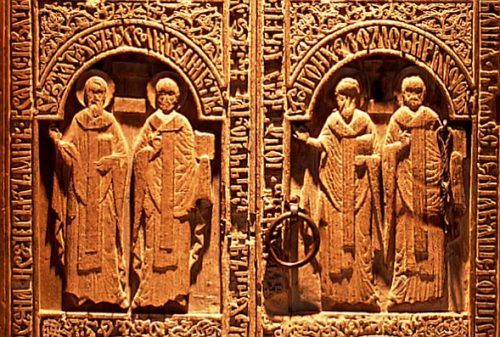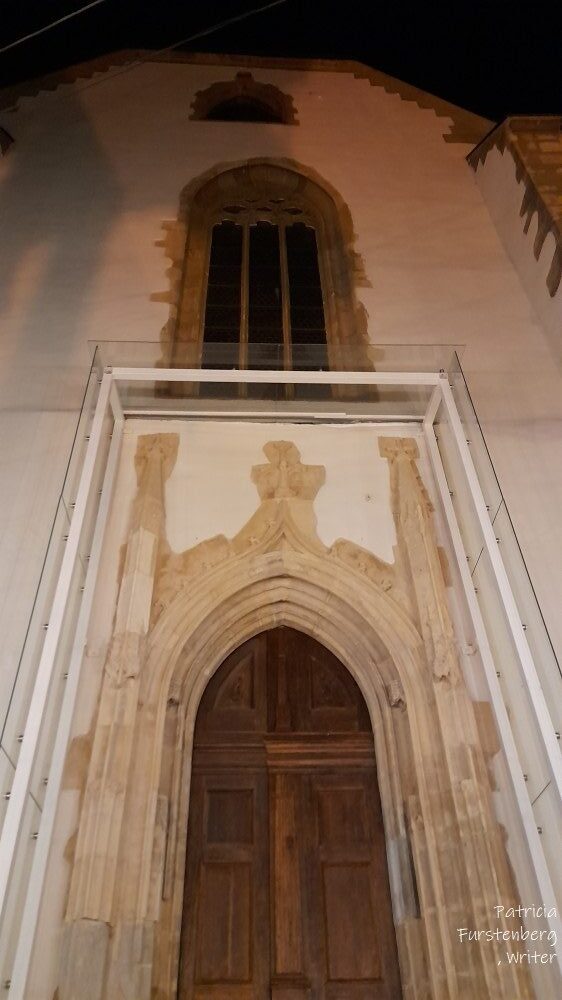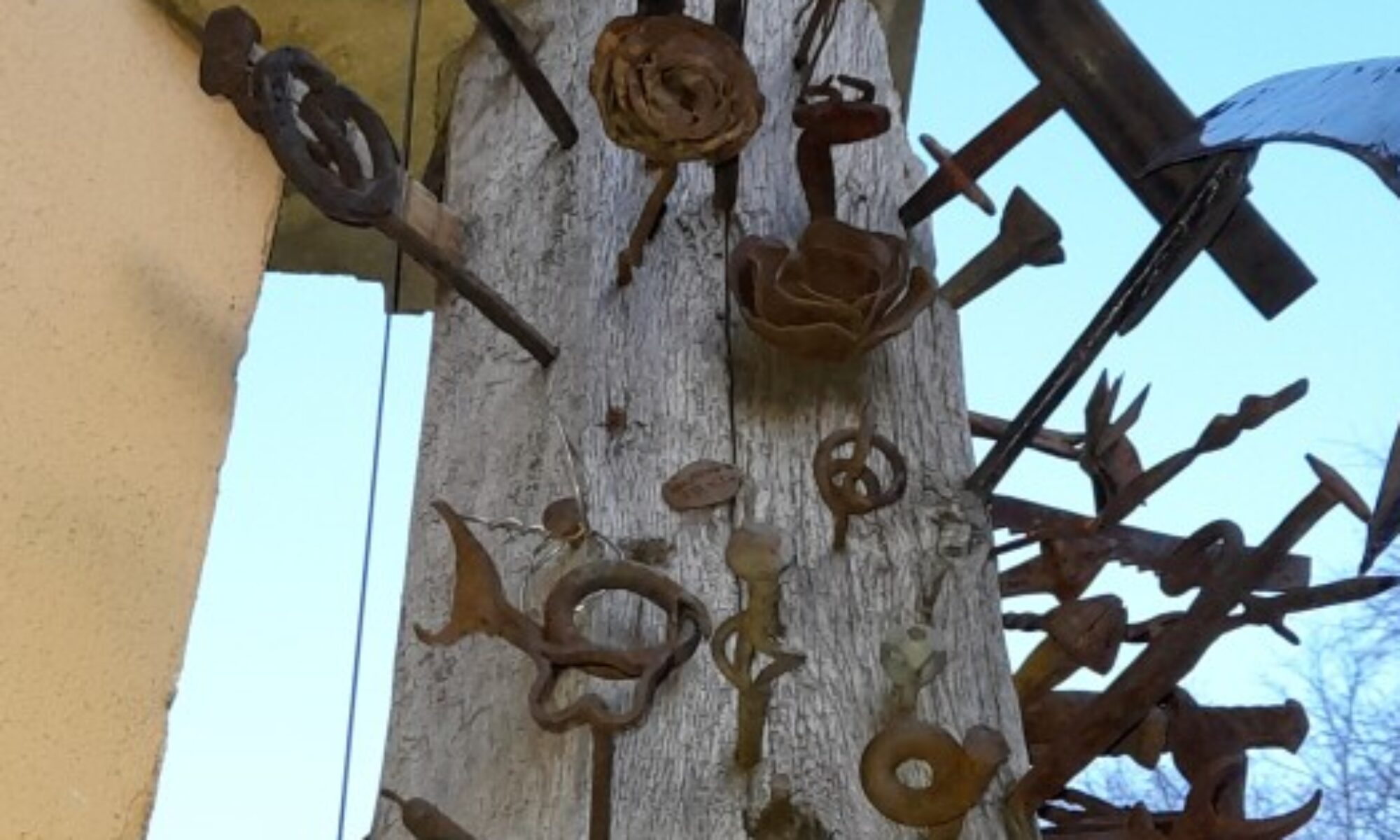The Door of Humility is small, plain, unlike any other church doors I’ve seen, yet it is Easter Time and I’d like to bring it forward together with a story, as its image emphasizes the importance of humility and modesty in matters of faith and spirituality.

The Door of Humility, a Story
As the soldier approached the ancient stone church his horse’s hooves thudded against the cobblestone road and a small cloud of dust announced his arrival. Not the resounding entrance he would have liked.
The sun had plunged below the horizon, casting a pale orange glow over the landscape, and the evening air was crisp with a hint of chill.
A church stood majestically before him, its limestone walls unblemished by stories from centuries past. The soldier dismounted his horse, a sturdy Turkoman named Emir, to command, for the way he held himself in battle, and tethered him to a nearby pillar disregarding its proximity to the holy place. Adjusting his armor and weapons, he made his way towards the entrance of the church, treading firmer than necessary.
He strode towards the entrance of the church. A grand archway stood above him. Adorned with intricate carvings of biblical scenes, it nestled wooden doors, studded with iron nails weathered by centuries of use. The soldier approached the doors with scorn, pausing not because of the solemnity of the place, but to check if any locals saw him. If any natives witnessed his arrival.
The surroundings of the big church looked deserted. Only his breath puffed in his ears. And his blood, whooshing, echoing the snort of his horse.
The soldier slapped his palms against the carved wood and pushed open the heavy doors. They barely moved, the thick wood heavy with story and loving craftsmanship. They creaked, and the soldier inhaled raw anger. Past the red clouds that danced in front of his eyes he saw the dimly lit interior of the church. The scent of incense filled his flaring nostrils, sweetness mingling with the musty smell of old stone. The soldier stepped inside, his boots echoing softly on the stone floor. So he stomped louder.
The interior of the church was awe-inspiring. The high-vaulted ceilings were adorned with frescoes depicting biblical scenes, their colors muted by the passage of time. Candlelight flickered in the dimness, casting shadows that danced on the walls.
As the soldier made his way further into the church, he felt a sense of reverence wash over him. But he shook it off and strode further. The hushed whispers of prayers hummed through the air, and the flickering candlelight seemed to guide his way.
Yet none turned to look at him.
The soldier reached the front of the church, where the altar stood bathed in a warm golden light. The intricately carved marble was adorned with candles and flowers, and the flickering flames danced on its surface.
An old man in a tattered cloak has knelt before the altar, his head bowed in prayer. The soldier could not make out the words, but he senses that the old man offered thanks. Something his father would do too, for his son’s safe return from battle. And for the lives lost in conflict. His father…
The soldier shook himself. This was not the time, nor the place. His father will have to wait, his son was still far, far away from Antalya.
Beyond the old man, the soldier noticed a small door to the side of the altar. Three slabs of stone framed it. It was adorned with a simple wooden sign that read “Door of Humility.” Intrigued, he approached it, wondering what secrets it held.
Secrets often meant treasures.
He pushed it open, revealing a narrow and low passage. Ha! He won’t fit though! He turned, about to give up, when he noticed the old man watching him. Was tat a glint of irony in the wrinkled eyes? He threw his chin in contempt and removed his head gear, the turban helmet with its pointy tip, and his yatagan. Then, bringing his shoulders forward, pushed through, grunting. He had to crouch and bend to enter, but he was determined to see where the door and the corridor led. He navigated the narrow passage, feeling the coolness of the stone against his skin. The tunnel was not long, perhaps ten well-paced breaths, but it felt much longer, crowded as it was. And stooped in history.
The stone was rough against his cheek, ice cold. It’s been the same that one time he fell in the well. Although dry, he thought he’ll die. He would have, if his mother wouldn’t have come searching for him. She’d said she felt something happened.
The corridor turned dark as soon as the door closed behind him. Dark had been the cellar where he went to fetch the cheese. The cellar that hid the spirits of the dead, as his older brother swore by. Had his father not come to check on him, he would have died of fear. He just knew it. As his father did, sensed that something ha gone amiss.
His steps whispered until he reached the end.
To his surprise, he found himself in a small chamber adorned with simple wooden furnishings. The walls were bare, and the only light came from a small window that overlooked the churchyard. It was a humble and peaceful space, far removed from the grandeur of the main church.
Here, he was all alone.
The soldier sat down on a wooden bench, feeling a sense of humility and reverence wash over him. He reflected on the fleeting nature of life. On the constancy of love and family. On the importance of faith, of having faith, and the power of humility in the face of grandeur and glory.
After spending some time in quiet contemplation, the soldier made his way back through the narrow passage and emerged from the Door of Humility. Treading softly, he exited the church with a renewed sense of purpose and humility, grateful for the opportunity to have experienced such a moment of reflection in the midst of a tumultuous war.
As the soldier left the Church of Nativity, his heart filled with a newfound understanding of the power of humility, and a renewed appreciation for the sanctity of the sacred space he had just visited.
Copyright © Patricia Furstenberg. All Rights Reserved.

We haven’t visited the Church of the Nativity in Bethlehem yet, we haven’t even been near Levant, but when we will, and I hope soon, I’ll take pictures and update this blog post. The other church doors posted below come from our travels.
The Door of Humility and its story came to mind by chance, or perhaps not, as I’ve been thinking of ways to connect this Thursday Doors post with Easter. I am in awe of the simple, but heartwarming sight of the Door of Humility, and of how different it is from other church doors I’ve seen.

The Door of Humility
The Door of Humility, also known as the Door of Humbleness or Gate of Humility is a prominent feature of the Church of Nativity in Bethlehem, Palestine. This church was built on the site of the stable where it is believed that Mary gave birth to Jesus.
The Church of the Nativity was commissioned by Roman Emperor Constantine around 326 AD. Constantine the Great was the first emperor to convert to Christianity (312 AD). Together with his Greek and Christian mother, Helena, Constantine commissioned the building of various churches to mark and commemorate important locations in the Christian history.
In 565 AD Roman Emperor Justinian I, Justinian the Great (remembered as the emperor who dreamed to restore the Roman Empire to its former glory) rebuilt the initial basilica destroyed by fire. The alterations include the reduction in the size of the door that was originally an arch.
According to the legend, the Door of Humility was designed to be intentionally low and narrow (1.5meters in height, or 5 feet tall), forcing even the most high-ranking church officials to bow down and humble themselves in order to enter the church. Other stories say that it was reduced in height on purpose, so people on carts and horses won’t be able to get inside.
This symbolic act of humility was meant to remind Christians of the importance of humility and modesty in their faith, and to discourage pride and arrogance among the religious leaders.

Today, whoever passes through the Door of Humility, pilgrims and visitors from around the world, stoop down and bow their heads following the tradition of humility that has been associated with it for centuries. Just as the Magi did in front of baby Jesus, after they followed the star for days, traveling with their gifts.

The legend of the Door of Humility serves as a reminder of the importance of humility, reverence, and respect in matters of faith and spirituality. It highlights the significance of putting aside differences and embracing humility as a virtue that brings people together, and serves as a symbol of the enduring legacy of this principle in the rich history of the Church of Nativity.

Whether you celebrate Easter this Sunday or the next (we have motives to celebrate both), or observe other festivities, I wish you a blessed and peaceful time with your loved ones.

Beautiful doors and a wonderfully appropriate story for Easter, Patricia. IT was nice to see that door, and to think about the powerful forces surrounding it. Thanks for sharing these photos and that story.
My absolute pleasure, Dan. This story holds a special significance to me.
Thank you for supporting all the Thursday Doors participants. Each week something new to learn or to see.
That’s exactly why I love this challenge.
This is such an inspiring post, Patricia, no matter what a person’s religious beliefs. I’ve made you the author of the week on my website and will link to your post!
Thank you for sharing,
Gina
Ah Gina, thank you so very much for your words of encouragement. They mean so much to me! I appreciate you sharing your thoughts.
Gina, I am honored by your nomination. You are such an accomplished and dedicated reviewer and blogger!
Thank you!
Beautiful doors and such an inspiring story. Lovely, Patricia.
I am so glad you enjoyed my story, Miss Judy. I appreciated your flash fiction very much lately.
Happy Spring to you!
<3
A great look into history through doors.
Thank you so much!
What a moving and amazing story. Happy Easter Patricia!
A Blessed and Happy Easter to you and yours too, Cindy.
Thank you for the gorgeous Ranuculus in bloom you shared with us on your blog!
A very enjoyable story to read. Thank you and happy Easter.
Thank you so much, Danny. Your novels are such a treat to read, so I do appreciate your words.
A Happy Easter to you too! 🙂
The story is very poignant. We all should pass through a door of humility from time to time, even if imaginary. I have one amendment, if you allow me. The horse of the soldier seems to be male. Then he’s not a mare, but a stallion. Anyway, looking forward to seeing the pictures from your future trip to the Church of the Nativity in Bethlehem.
Yes, beautiful said, Jo.
Thank you for reading and spotting. Of course, I don’t know what was in my head when I wrote that. I typed the story straight in WP, afraid that if I’ll write it in a MS Word doc I’ll edit well past Easter and it will never see the light of day.
Well, I hope you will stick around for the next years, to get to see that update 🙂
Thanks for this excellent post and story, Patricia. It is important to remember humility as part of our Christian following. It was that lack of humility that corrupted so many during the time of Jesus.
Carla, yes, indeed, ad so many times afterwards, as history showed us.
I believe it was CS Lewis who said that humility doesn’t mean to think less of ourselves, but to think of ourselves less.
Thank you for sharing your thoughts 🙂
Wishing you and yours a blessed and happy Easter!
Beautiful post and doors Pat and Happy Easter! ❣️
A Blessed Easter to you and yours, Cindy!
Thanks Pat! ❣️
Thank you so much Patricia for sharing the history and some relevant facts about the Door of Humility and your beautiful story inspired by it.
With greatest pleasure, Blanca. 🙂